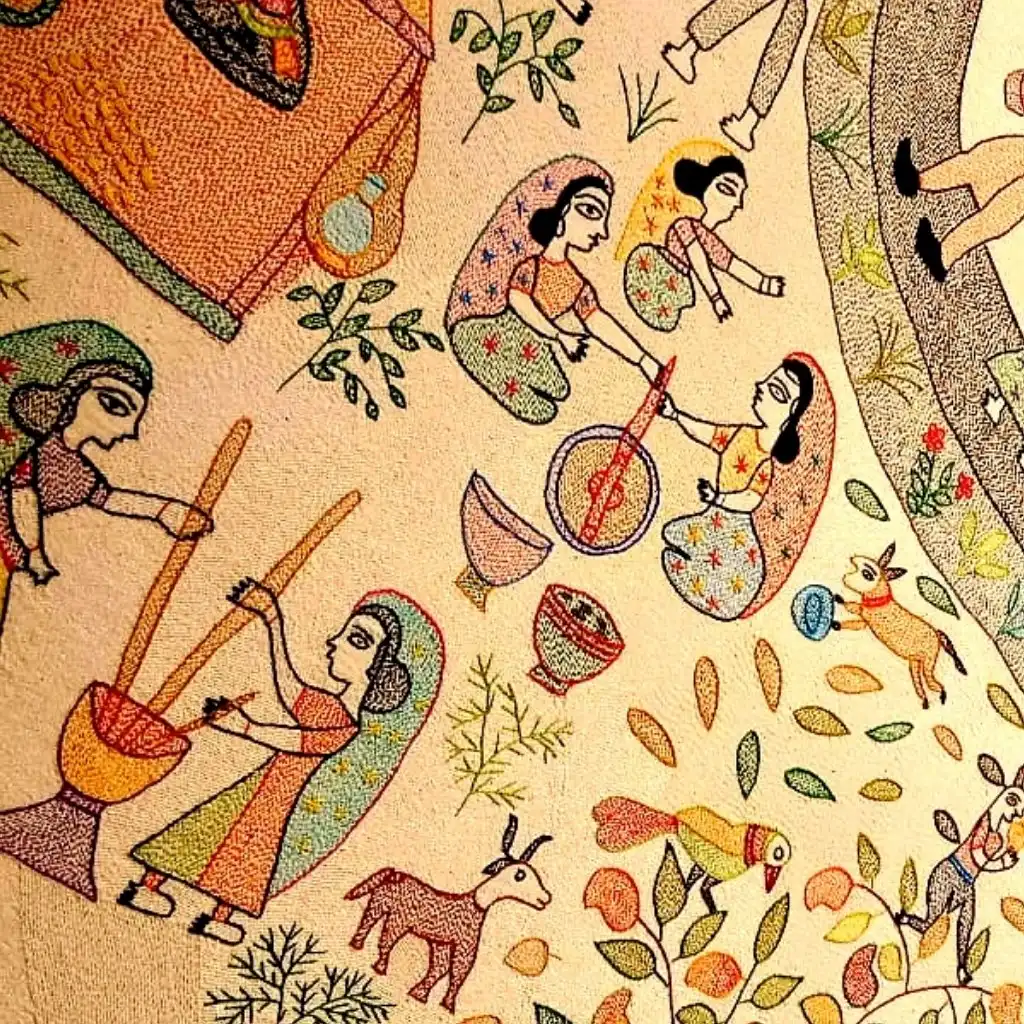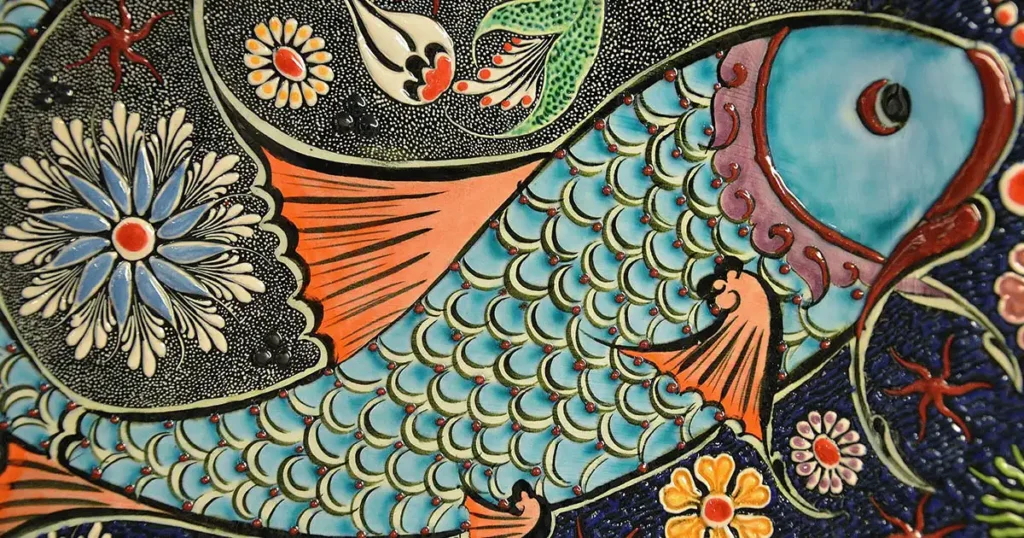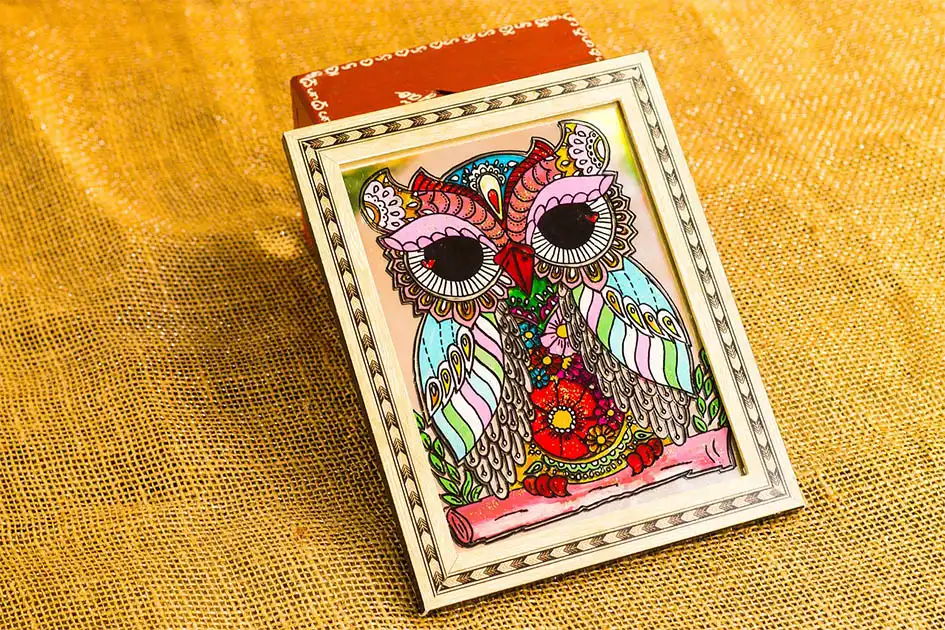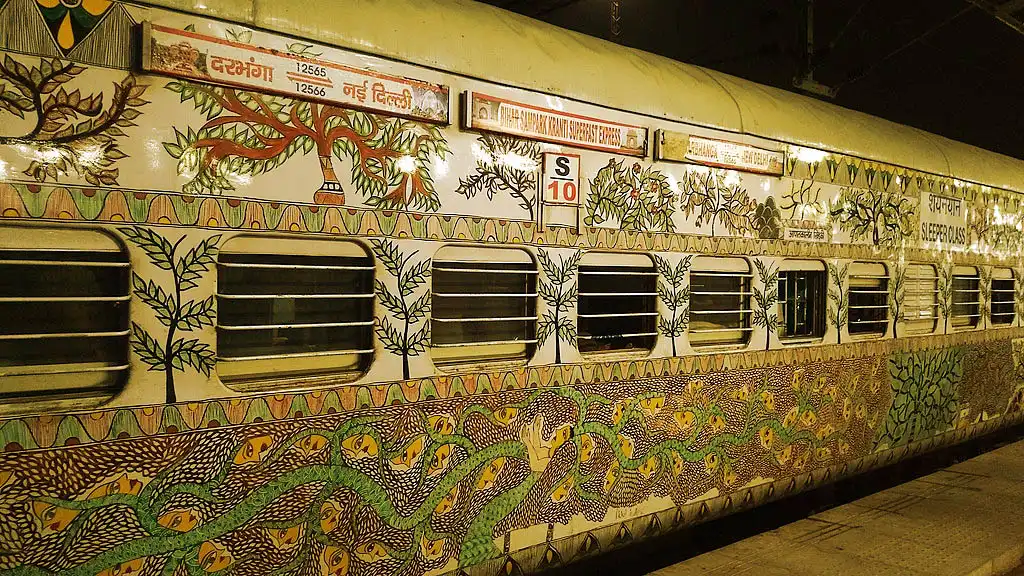In this article, we will cover the 10 incredible facts about Madhubani Paintings. Before we dive deep into the facts, let’s first explore its history and themes.
Madhubani Paintings is an art form that originated in Bihar, India. It is also called Mithila painting and it’s one of the oldest forms of Indian paintings, having a rich history dating back over 2,500 years. They originated in the Mithila region of Bihar, India, and were traditionally created by women on the walls of their homes.
The history of Madhubani paintings dates back to the days of Ramayana.
Themes in Madhubani paintings are based on mythology, religion, and nature. The artistic process involves mixing white sand with rice paste or wheat flour and applying different colors over it.
History of Madhubani Paintings
Madhubani paintings are a traditional art form of the Mithila region in India. They have been practiced since the Ramayana and Mahabharata, both written and oral epics that tell stories about Lord Rama, Krishna, and Arjuna respectively.
The paintings are made using different kinds of everyday materials like marigolds, Henna leaves, mud, wheat flour paste, bougainvillea, cow dung, soot, watercolors, and rice powder or lime. Which are then applied onto cloths (or paper) using brushes or fingers. The finished product can be used for decorating walls as well as for artistic purposes such as writing messages on them or adding pictures inside them like flowers or animals etc.
Themes
Madhubani paintings are often based on mythology, folklore, and religious beliefs. Some of them depict social issues in society while others depict daily life; they also show nature as part of their theme. Themes are different for each artist, but all have one thing in common – they are colorful, vibrant, and full of imagination!
You can find these themes in most paintings:
- Mythology – This includes stories about gods or goddesses who were once human beings like you or me; it also talks about how humans came into existence after being created by gods (or something else).
- Folklore – It means traditional stories that have been passed down from generation to generation through oral transmission through ages from one culture to another (for example, Indian culture).
State in Which it is Practiced
Madhubani paintings are practiced in the Mithila region. It is a region in the Indian state of Bihar, which has a distinct culture and language, Maithili.
The region has a rich history and heritage and is famous for its handicrafts like pottery, woodcarving, and especially Madhubani paintings.
10 Incredible Facts about Madhubani Paintings
Fact #1: Women-Centric Artform
Traditionally, Madhubani paintings were primarily created by women in the Mithila region of Bihar, India. This art form was passed down from generation to generation, with mothers teaching their daughters the intricate techniques, motifs, and styles of Madhubani painting. It was a way for women to express their creativity and preserve their cultural heritage.
The art of Madhubani painting was closely associated with women’s daily lives, rituals, and celebrations. Women would decorate the walls of their homes with these vibrant paintings during festivals, weddings, and other auspicious occasions. The art form not only served as a means of artistic expression but also as a social and cultural bonding activity among women in the community.
Fact #2: It Uses Natural Colors
Madhubani paintings are known for their use of natural colors derived from various organic sources.
The artists traditionally use natural dyes and pigments extracted from plants, flowers, vegetables, and minerals found in the local environment.
These natural colors lend a distinct charm and earthy feel to the artwork. Here are some examples of natural colors commonly used in Madhubani paintings:
Turmeric (Haldi): It produces a vibrant yellow color and is derived from the turmeric root.
Indigo (Neel): It gives a deep blue color and is obtained from the leaves of the indigo plant.
Vermilion (Sindoor): It provides a bright red hue and is derived from the powdered cinnabar mineral.
Rice Paste (Chawal ka paste): It acts as a binder and base for other colors, lending a white or off-white background to the paintings.
Flowers: Extracts from flowers like marigold (orange), jasmine (white), and tesu (yellow-orange) are used to produce different shades.
Leaves: Certain leaves, such as betel (green) and mehndi (henna) leaves, are used for creating green tones.
These natural colors not only add vibrancy and depth to Madhubani paintings but also contribute to their eco-friendly nature. The use of organic pigments enhances the overall aesthetic appeal and authenticity of this ancient art form, connecting it closely to nature and the environment.
In recent times, while some artists continue to use natural colors, others have also experimented with commercial acrylic paints to achieve a wider range of colors. However, the essence and charm of traditional Madhubani paintings lie in their use of natural colors, reflecting the deep-rooted connection between art, culture, and the natural world.
Fact #3: Madhubani Paintings Often Depict Culture, Mythological Stories, and Folklore

Madhubani paintings are renowned for their depictions of culture, mythological stories, and folklore. These paintings serve as a visual narrative, capturing the rich cultural heritage and traditional beliefs of the Mithila region in Bihar, India.
Here are some key aspects of Madhubani paintings about culture, mythology, and folklore:
Cultural Depictions
Madhubani paintings reflect the cultural ethos and practices of the region. They often depict scenes from everyday village life, showcasing activities like farming, cooking, weddings, and festivals. These paintings serve as a medium to preserve and showcase the unique cultural traditions of the Mithila community.
Mythological Stories
Madhubani paintings frequently draw inspiration from Hindu mythology. They depict various Gods, Goddesses, and characters from ancient Indian epics like the Ramayana and Mahabharata.
Artists skillfully portray the narratives, exploits, and symbolic representations of these figures through intricate detailing and vibrant colors.
Folklore and Legends
Madhubani paintings also capture local folklore and legends. These stories passed down through generations, often revolve around historical events, legendary figures, and folk heroes. The paintings act as a visual medium to preserve and pass on these oral traditions, serving as a cultural repository.
By depicting culture, mythological stories, and folklore, Madhubani paintings not only serve as artistic expressions but also provide a means of storytelling, cultural preservation, and celebration. They offer a glimpse into the vibrant traditions, beliefs, and narratives that have shaped the identity of the Mithila region and continue to captivate art enthusiasts and culture enthusiasts alike.
Fact #4: Intricate Designs
The paintings are characterized by intricate and repetitive patterns created using fine lines and dots. These patterns are meticulously drawn using a bamboo stick or a nib made from cotton wrapped around a twig.
Geometric patterns, including circles, triangles, and dots, are indeed common elements found in Madhubani paintings. These patterns play a significant role in enhancing the visual appeal and overall aesthetic of the artwork. Here’s how geometric patterns are incorporated into Madhubani paintings:
Circles
Circles are widely used in Madhubani paintings and often represent the sun, the moon, or the cyclical nature of life. They can be seen as halos around deities or used to depict floral motifs. Circles also symbolize harmony, unity, and completeness in the composition.
Triangles
Triangles are another prominent geometric element in Madhubani paintings. They can represent mountains, trees, or sacred feminine energy. Triangles are often used to form the bodies of animals, adding a dynamic and angular aspect to the artwork.
Dots
Dots are extensively used to fill spaces and create intricate patterns in Madhubani paintings. These dots, known as “bindis,” are made with the end of a twig or brush and are used to form elaborate designs, highlight details, and add texture to the artwork.
Grids and Borders
Geometric grids and borders are often employed to define the composition and provide a structured framework for the painting. These grids act as guides for maintaining symmetry, balance, and proportion within the artwork.
The use of geometric patterns in Madhubani paintings adds visual appeal and carries symbolic meanings. The precise and intricate arrangement of these patterns showcases the artist’s skill and attention to detail.
Fact #5: Each Symbol Carries Symbolic Meaning

Each element and motif in Madhubani paintings carries significant symbolic meaning. The artists use these symbols to convey deeper messages, beliefs, and cultural significance. Here are some common symbols found in Madhubani paintings and their associated meanings:
Peacock
The peacock is a recurring motif in Madhubani paintings and represents beauty, love, and immortality. It is also associated with the Hindu deity Lord Krishna and is considered a symbol of divine grace.
Lotus
The lotus flower symbolizes purity, spirituality, and enlightenment. It is often depicted in Madhubani paintings as a divine symbol and represents the unfolding of one’s inner self.
Fish
Fish is a prominent motif and symbolizes fertility, abundance, and good luck. It is believed to bring prosperity and is often associated with the goddess of wealth, Lakshmi.
Sun and Moon
The sun represents energy, power, and life force, while the moon symbolizes tranquility, femininity, and creativity. The presence of these celestial bodies signifies the balance between opposing forces and the cyclical nature of life.
Tree of Life
The Tree of Life is a common motif in Madhubani paintings and symbolizes fertility, regeneration, and the interconnectedness of all living beings. It represents the deep connection between humans, nature, and the universe.
Kundalini
Kundalini, depicted as a coiled serpent, represents the dormant spiritual energy within an individual. Its awakening signifies spiritual growth, transformation, and enlightenment.
Mandala
Mandalas are intricate geometric patterns that represent wholeness, unity, and spiritual harmony. They serve as a meditative tool and depict the cosmic order and interconnectedness of all things.
Birds and Animals
Various birds and animals, such as elephants, peacocks, parrots, and cows, are depicted in Madhubani paintings. Each animal carries its symbolic significance, representing qualities like strength, wisdom, and divinity.

These are just a few examples of the symbolic motifs used in Madhubani paintings. The artists carefully choose and arrange these elements to convey specific messages, stories, and cultural beliefs. The use of symbols adds depth and layers of meaning to the artwork, making Madhubani paintings not just visually captivating but also rich in cultural and spiritual significance.
Fact #5: The Painting Promotes Women’s Empowerment
Madhubani paintings were exclusively created by women in the Mithila region of Bihar, India. This art form was passed down from generation to generation, with mothers teaching their daughters the intricate techniques, motifs, and styles of Madhubani painting. It was a way for women to express their creativity and preserve their cultural heritage.
Madhubani paintings played a significant role in the lives of women in the community. They were not only an art form but also a means of social and cultural bonding among women. Women would gather together to create these paintings, sharing stories, songs, and traditions while working on their artwork. It provided them with a sense of community, camaraderie, and a way to pass down their cultural legacy.
In addition to being a form of artistic expression, Madhubani paintings have also provided women with economic empowerment. As the art form gained recognition and appreciation beyond the local community, women artists, known as “Madhubani artists,” started showcasing their talent and selling their artwork. This allowed them to generate income and contribute to their household finances, thereby gaining economic independence.
Through Madhubani paintings, women have not only preserved their cultural heritage but also gained recognition as skilled artists. Their contribution to the art form has been celebrated, and they have become ambassadors of the rich Mithila culture. Madhubani paintings have provided a platform for women to showcase their talent, creativity, and cultural heritage to the wider world.
Today, while men have also started practicing Madhubani painting, it remains a domain primarily dominated by women. The involvement of women in Madhubani paintings has not only empowered them as artists but has also provided them with a source of income, economic independence, and a platform to share their stories and traditions. The legacy of women’s contribution to Madhubani painting continues to be celebrated, and their role in preserving and promoting this art form remains significant.
Fact #6: Madhubani Painting Has Different Styles
Madhubani paintings are categorized into different styles based on the region, the artist’s techniques, and the distinctive characteristics of the artwork. These styles showcase the diversity and artistic variations within the Madhubani painting tradition. Here are some of the prominent styles of Madhubani paintings:
Bharni Style
The Bharni style is known for its vivid and vibrant use of colors. It involves filling the entire space with bright hues, creating a visually captivating and energetic effect. This style often depicts nature, animals, deities, and mythological stories with rich detailing and intricate designs.
Kachni Style
The Kachni style is characterized by its cross-hatching technique. The artists use parallel lines or cross lines to create texture, depth, and shading in the painting. This style often features geometric patterns, repetitive motifs, and intricate detailing.
Tantrik Style
The Tantrik style of Madhubani painting is deeply rooted in ritualistic practices and spiritual symbolism. It incorporates intricate designs and symbolic representations of gods, goddesses, and mystical elements. The Tantrik style often focuses on depicting divine energy and cosmic forces.
Godna Style
The Godna style is reminiscent of tattoo-like patterns. It draws inspiration from the traditional practice of adorning the body with decorative tattoos. This style often features intricate patterns, repetitive designs, and symbolic motifs inspired by body art.
These different styles of Madhubani paintings highlight the creativity, techniques, and artistic expressions of the artists. Each style has its own unique characteristics and storytelling elements. Artists may specialize in one particular style or experiment with a combination of styles to create their signature approach.
The categorization of Madhubani paintings into different styles adds to the diversity and richness of this art form. It allows artists to explore various techniques, themes, and cultural influences, ensuring that Madhubani paintings continue to evolve and captivate art enthusiasts worldwide.
Fact #7: Madhubani paintings Have Gained Global Recognition
Madhubani paintings have gained international acclaim for their beauty and cultural significance. They have been exhibited in prestigious art galleries and museums worldwide, bringing recognition and appreciation to this traditional Indian art form.
The global recognition and appreciation for Madhubani paintings have played a crucial role in showcasing the rich artistic heritage of the Mithila region and the talents of the artists behind them.
Here are some key points highlighting the international recognition of Madhubani paintings:
Global Exhibitions
Madhubani paintings have been featured in prominent art exhibitions worldwide, allowing a wider audience to experience and appreciate this traditional Indian art form. These exhibitions often showcase the intricate detailing, vibrant colors, and storytelling elements that make Madhubani paintings unique.
Museum Collections
Madhubani paintings have found a place in renowned museum collections globally. Institutions such as the Victoria and Albert Museum in London, the Museum of Ethnology in Vienna, and the Museum of Asian Art in Berlin house collections that include exceptional Madhubani artworks. These museums recognize the cultural significance and artistic excellence of these paintings.
International Art Fairs
Madhubani paintings have been showcased and sold at prestigious international art fairs, including events like Art Basel and India Art Fair. The presence of Madhubani paintings in such esteemed art platforms helps promote the art form to a global audience and attracts art collectors and enthusiasts.
Cross-Cultural Collaborations
Madhubani artists have engaged in cross-cultural collaborations, partnering with international artists, designers, and brands. These collaborations have resulted in unique artistic projects, fusion artworks, and product designs that blend the traditional Madhubani style with contemporary influences. Such collaborations have further elevated the global recognition of Madhubani paintings.
The international acclaim for Madhubani paintings not only celebrates their aesthetic beauty but also recognizes their cultural significance and the skill of the artists. It has opened doors for cross-cultural dialogue, appreciation of traditional art forms, and the preservation of cultural heritage. The global recognition and exposure have not only given Madhubani paintings a wider reach but have also contributed to the economic empowerment of the artists and the community.
As Madhubani paintings continue to captivate art lovers worldwide, they serve as a testament to the enduring legacy and artistic brilliance of this traditional Indian art form.
Fact #8: Inscribed on the UNESCO Representative List of the Intangible Cultural Heritage
In 2021, Madhubani paintings were inscribed on the UNESCO Representative List of the Intangible Cultural Heritage of Humanity, recognizing their cultural importance and the need to safeguard this traditional art form.
Fact #9: Madhubani Art is Not Limited to Paper or Walls

Madhubani art is not limited to paper or walls; it extends to various other surfaces and mediums as well. The versatility of Madhubani art allows artists to explore and adapt their traditional techniques to different materials. Here are some examples of how Madhubani art is applied to various surfaces:
Textiles
Madhubani art is often seen on textiles, including sarees, dupattas, stoles, and fabrics used for home decor items like cushion covers, table runners, and wall hangings. The intricate and vibrant designs of Madhubani paintings add a touch of traditional elegance to the textiles, making them unique and visually captivating.
Ceramics and Pottery
Madhubani art has found its way onto ceramics and pottery as well. Artists use their painting skills to adorn clay pots, plates, bowls, and other ceramic objects with Madhubani motifs. The earthy texture of ceramics complements the bold and intricate patterns of Madhubani art, creating stunning decorative pieces.
Murals and Wall Paintings
While Madhubani paintings have traditionally adorned the walls of homes in Bihar, they have also been adapted for larger-scale murals and wall paintings. These colorful and eye-catching murals can be seen on public buildings, schools, community centers, and even in art installations, adding a vibrant touch to the surroundings.
Paper and Canvas
Though Madhubani art originated on paper and walls, it is still widely practiced on these surfaces. Artists create intricate and detailed paintings on handmade paper, using natural colors and traditional techniques. Additionally, Madhubani art is also done on canvas, allowing for more flexibility in terms of size and portability.
Contemporary Adaptations
With the changing times, Madhubani art has embraced contemporary mediums as well. Artists have applied their traditional techniques to mediums like acrylics, digital art, and even mixed media, giving rise to unique and innovative interpretations of Madhubani art.
Fact #10: The Indian Government Has Played a Significant Role in Madhubani Painting
The Indian government has played a significant role in recognizing and supporting Madhubani art, providing platforms for artists to showcase their talent and preserve this cultural heritage. Here are some ways in which the Indian government has contributed to the promotion and support of Madhubani art:
National and State Awards
The Indian government confers prestigious national and state awards to recognize the mastery and contribution of Madhubani artists. These awards not only honor the artists but also bring attention to the art form itself, encouraging its preservation and continued practice.
Government-Sponsored Exhibitions and Workshops
The government sponsors exhibitions, workshops, and art fairs at both national and state levels to promote Madhubani art. These events provide artists with opportunities to exhibit their work, connect with art enthusiasts, and share their knowledge and techniques with a wider audience.
Financial Support and Scholarships
The government offers financial support and scholarships to Madhubani artists, especially those from marginalized backgrounds or economically disadvantaged communities. These initiatives aim to encourage talent, empower artists, and ensure the continuity of this traditional art form.
Handicraft Development Corporations
The government has established handicraft development corporations at the national and state levels to support and promote traditional arts and crafts, including Madhubani art. These organizations provide resources, training, and marketing platforms for artists, helping them gain visibility and economic opportunities.
Cultural Festivals and Events
The government organizes cultural festivals and events that showcase Madhubani art alongside other traditional art forms. These events celebrate the rich cultural heritage of India and provide a platform for artists to engage with a diverse audience, both domestically and internationally.
UNESCO Recognition
The inscription of Madhubani paintings on the UNESCO Representative List of the Intangible Cultural Heritage of Humanity in 2021 is a testament to the recognition and support provided by the Indian government. This recognition highlights the cultural significance of Madhubani art and reinforces the need for its safeguarding and promotion.
Through these initiatives and support, the Indian government has played a vital role in preserving and promoting Madhubani art as a valued cultural heritage of the country. By providing platforms, financial assistance, and recognition, the government has ensured that Madhubani artists receive the support they need to continue practicing and passing down this traditional art form to future generations.
You may also like:
- 20 Incredible Facts About Indian History
- 20 Great Indian Discoveries & Inventions
- 20 Amazing Facts About India
- 20 Interesting Facts About Narendra Modi
Madhubani Paintings Facts: Conclusion
In conclusion, Madhubani paintings hold a significant place in Indian art and culture. This traditional art form, originating from the Mithila region of Bihar, has captivated people with its intricate designs, vibrant colors, and rich cultural symbolism.
The unique and diverse subjects depicted in Madhubani paintings, ranging from Hindu deities and mythological stories to nature, animals, and social issues, showcase the depth and breadth of this art form.
One of the interesting facts about Madhubani paintings is that they are traditionally created using natural dyes and pigments. Artists use materials like rice paste, turmeric, and plant-based colors to bring the artwork to life. Brushes are often handmade using twigs, bamboo sticks, or even fingers.
The themes of these paintings are usually centered around Hindu mythology, nature, and daily village life. Common motifs include flowers, animals, gods, and geometric patterns, all meticulously detailed.
Another fascinating fact is that Madhubani art was originally done on walls and floors of homes, especially during festivals and important occasions like weddings. Today, it has found its place on paper, canvas, and even fabric, gaining recognition across the globe.
Madhubani paintings are not just about aesthetic beauty; they also reflect the deep-rooted traditions of the people. This timeless art form continues to evolve, preserving its traditional essence while captivating modern audiences.



